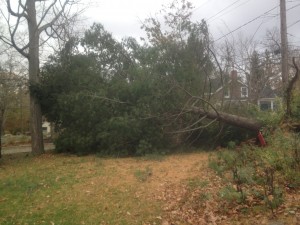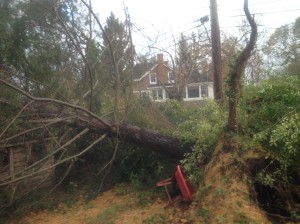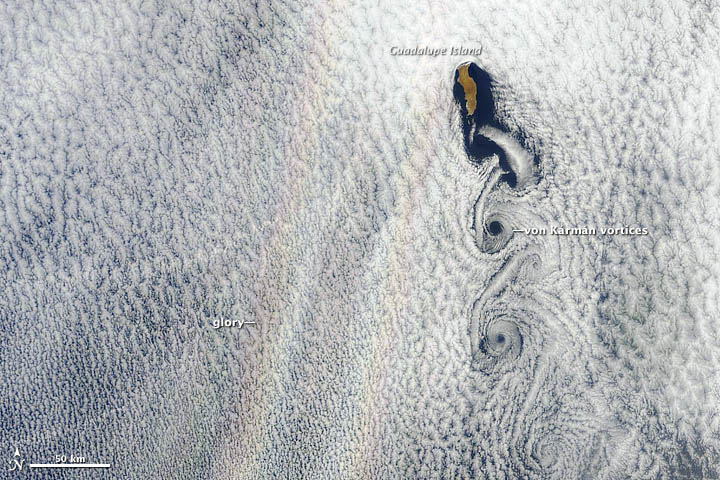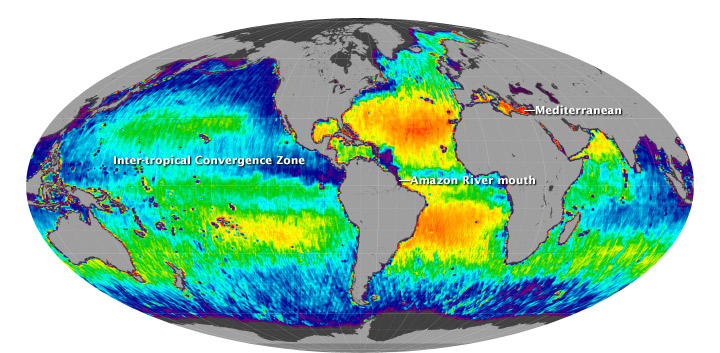These waves travel 10s of meters beneath the surface and are sometimes visible by satellite, as here.
These waves travel 10s of meters beneath the surface and are sometimes visible by satellite, as here.
 Some approximate numbers: about 40 feet tall, 60″ around at chest-height, 20″ in diameter. According to the growth multiplier for white pine, that means roughly 100 years old. Which takes us back to 1912, before my parents were born and before our house was built. I imagine the tree was planted to mark the northeastern corner of the rock wall that now borders our property. When it was built it marked the edge of the estate that then filled up almost all of our neighborhood, before smaller properties were carved out of it after WWII.
Some approximate numbers: about 40 feet tall, 60″ around at chest-height, 20″ in diameter. According to the growth multiplier for white pine, that means roughly 100 years old. Which takes us back to 1912, before my parents were born and before our house was built. I imagine the tree was planted to mark the northeastern corner of the rock wall that now borders our property. When it was built it marked the edge of the estate that then filled up almost all of our neighborhood, before smaller properties were carved out of it after WWII.
This tree’s life was not quite on a nonhuman time scale, but it’s been through a lot of storms, including some bigger than Sandy: Gloria in 1985 and the great storm of 1938, among others. 
I’d been worried about storm surge, which turned out to be a bit less than Irene, though it still produced major flooding just a bit downhill from us. We’re all fine, but it’s odd that our damage came from being high, not low. This tree was probably one of the highest points in our little neighborhood, which exposed it to the full force of the east wind. We’re very lucky it didn’t fall on the house, though a little playhouse we put in for the kids years ago is underneath it. Still standing, as far as I can tell.
The tree came down around 7 pm, two hours after the power cut out. I was sitting on that side of the house with the kids telling stories when we heard a muffled thump and then a sharp bang. We jumped up away from the window, but the bang turned out to be just the power cable getting ripped off the wall. It was dark and hard to see, but as we peered through the glare of our flashlights, we eventually could make out the dark outline of a huge shape, lying sideways along the yard. We figured out what it was by looking at the hole in the skyline, visible by the full moon, on the corner of the property where the tree had been.
A few hours earlier, in the last of the power, I’d watched the Fangorn scenes from The Two Towers with the kids. Eald enta geworc, goes the Anglo-Saxon verse line from which Tolkien invented his tree-herders. The old work of giants.
 It may look like a cloud-rainbow, but it’s a “glory,” seen from above against a background of stratocumulus.
It may look like a cloud-rainbow, but it’s a “glory,” seen from above against a background of stratocumulus.

Like Lucretius I think Venus rules the universe. It was great to have the chance to see her this past week. I was especially lucky to have three chances to see, even though Transit Tuesday was cloudy in Short Beach —
Here she is via my old high school buddy Dan Gelfand’s picture of the celestial lady crossing the stage.

Here’s what I came up with, via emergency napkin camera, by the side of the road when the sun briefly came out:
And here’s another view, of my son dressed as Aphrodite in the school play:

After June, 1, we’re in the season. NASA says we’re in the post-La Nina pre-El Nino lull that they call “La Nada.” Still looks warm down there!
It’s cloudy in Short Beach, so I’m not sure if I’ll bother to assemble my pin-camera. But I’m amazed by the upcoming Transit of Venus, and can’t wait to see astronomical pix. I think I’ll check in via the SLOOH Space Camera once I drop Ian off at soccer practice.
During the 17c, observations of the Transit were a worldwide scientific craze. But we literary types know it best via Mason & Dixon, the pair having made observations of the Transit from the Cape of Good Hope in 1761 and 1769. In the novel, Mason takes the opportunity of the Transit to lecture the lovely ladies of the Vroom family:
‘Ladies, Ladies,’ Mason calls. ‘– You’ve seen her [i.e., Venus] in the Evening Sky, you’ve wish’d upon her, and now for a short time will she be seen in the Day-light, crossing the Disk of the Sun,– and do make a Wish then, if you think it will help. — For Astronomers, who normally work at night, ’twill give us a chance to be up in the Day-time. Thro’ our whole gazing-lives, Venus has been a tiny Dot of Light, going through phases like the Moon, ever against the black face of Eternity. But on the day of this Transit, all shall suddenly reverse, — as she is caught, dark, embodied, solid, against the face of the Sun, — a Goddess descended from light to Matter.’ (92)